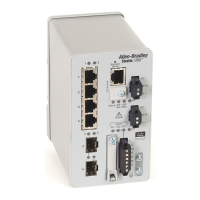Rockwell Automation Publication 1783-UM007G-EN-P - February 2017 265
Configure Switch Features Chapter 7
3. In the Name field, type a unique name to identify the instance.
The instance name cannot include spaces or exceed 32 characters.
4. Complete VLAN assignments:
• (Stratix 5700 and 5400 switches) For each uplink port on the right,
select each VLAN to assign to the instance.
• (Stratix 5410 switches) For each NAT port, choose an uplink or
downlink port, and then select each VLAN to assign to the instance.
The pull-down menu includes all ports (Gi1/1…Gi1/24 and
Te1/25 …Te1/28) and the default option None. When choosing
ports, these rules apply:
– You can configure as many as four NAT ports from Gi1/1…Gi1/6
and Gi1/13…Gi1/18.
– You can configure as many as four NAT ports from Gi1/7…Gi1/12,
Gi1/19…Gi1/24, and Te1/25…Te1/28.
– If four ports from Gi 1/1…Gi 1/6 and Gi 1/13…Gi 1/18 are already
in use, all other ports in that range are unavailable in subsequent
port selection lists.
– If you choose a downlink port, all uplink ports become unavailable,
and if you choose an uplink port, all downlink ports become
unavailable.
For more information about VLAN assignments, see
page 260.
5. In the Private to Public area, click Add Row, complete the fields, and
click Save.
Field Description
Private IP Address Type a private IP address:
• To translate one address, type the existing address for the device on the private subnet.
• To translate a range of addresses, type the first address in the range of sequential addresses.
• To translate addresses in a subnet, type the existing starting address for a device on the private subnet. This address must correspond to the size of the
subnet mask to translate.
Subnet Mask Starting Private Subnet Address
255.255.0.0 The last two octets must end in 0.
EXAMPLE: 192.168.0.0
255.255.255.0 The last octet must end in 0.
EXAMPLE: 192.168.1.0
255.255.255.128 The last octet must end in 0 or 128.
EXAMPLE: 192.168.1.0 or 192.168.1.128
255.255.255.192 The last octet must end in one of the following: 0, 64, 128, 192.
EXAMPLE: 192.168.1.64
255.255.255.224 The last octet must end in one of the following: 0, 32, 64, 96, 128, 160, 192, 224.
EXAMPLE: 192.168.1.32
255.255.255.240 The last octet must end in one of the following: 0, 16, 32, 48, 64, 80, 96, 112, 128, 144, 160, 176, 192, 208, 224, 240.
EXAMPLE: 192.168.1.16

